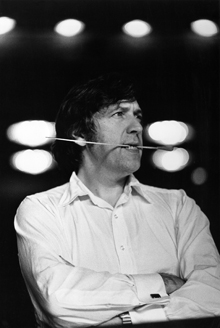
PRESCIENT Was Gunther Schuller the father of indie rock?
|
A definition of the term Third Stream probably comes best by way of illustration: a teacher known for his jazz and klezmer background coaching a progressive bluegrass band by telling them to listen to a late-Beethoven string quartet.At least, that's what Third Stream looks like today at the New England Conservatory, where Gunther Schuller created a department of that name 40 years ago. When Schuller coined the term, he was talking about "the offspring of the marriage of two mainstreams: classical and jazz." These days, what was the Third Stream department is called Contemporary Improvisation, and its students can include players with a broad variety of backgrounds. So, yes, a bluegrass singer studying jazz techniques as well as 16th-century counterpoint.
On November 29, the NEC celebrates the tradition with a concert titled "The Rebirth of Third Stream," which includes pieces with Third Stream implications, from the past to the present: George Russell's epochal "All About Rosie," as well as Ellington's "A Tone Parallel to Harlem," Gil Evans's arrangement of Tchaikovsky's "Arab Dance," pieces by Leonard Bernstein, Charles Mingus, and Steve Lacy, and an arrangement of Ran Blake's "Horace Is Blue," with the composer at the piano. (Blake was also the first chairman of the Third Stream department.)
The boundaries between jazz and classical are much more fluid now than they were 40 years ago. NEC's Ken Schaphorst, who is organizing the concert and will lead the NEC Jazz Orchestra, says, "I think that Gunther's vision of Third Stream has become the reality, to the degree that the discipline jazz musicians learn today, when they go to, say, the Conservatory, is actually much closer to the discipline that classical musicians learned when Gunther was coming up, and I would say classical musicians are much more interested in improvising."
Of course, genre classification is a dicey business — no one wants to be pigeonholed, least of all creative musicians. Bernstein, for instance, clearly made use of jazz and popular music in his "classical" pieces, when he wasn't writing popular musical theater like West Side Story. The Bernstein piece on the "Rebirth" bill is Prelude, Fugue and Riffs, which, Schaphorst notes, includes the tempo marking "fast and exact." "It's a little jazzy," says Schaphorst, "but it's more Stravinsky than Count Basie."
As for Ellington's "A Tone Parallel to Harlem," Schaphorst says, "Even though it's formally one of the most complex things Ellington ever wrote — and actually one of the most successful in terms of his longer pieces — it's jazz. Now, what makes it jazz — that's really hard to say. There's almost no real improvisation — everything is written out. In this case, I think it's more about swinging and playing with a personal voice than it is about taking a solo in the usual sense. . . . It's really complicated to say what separates jazz from classical music. All the music we're playing [in the concert] is deliberately in the cracks."
For Schaphorst, distinguishing between jazz and classical is more a matter of musical training and repertoire than it is about musical content. "More and more [classical] orchestras play Ellington. And I think that's great. And yet, having a big band play the piece when the players in the big band are trained in the jazz repertoire. . . they know what swing is, they've played that music. It has a very different meaning."